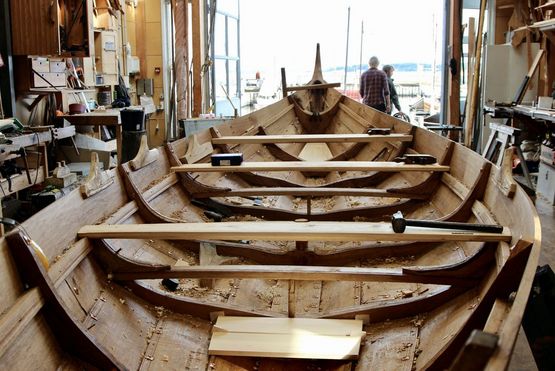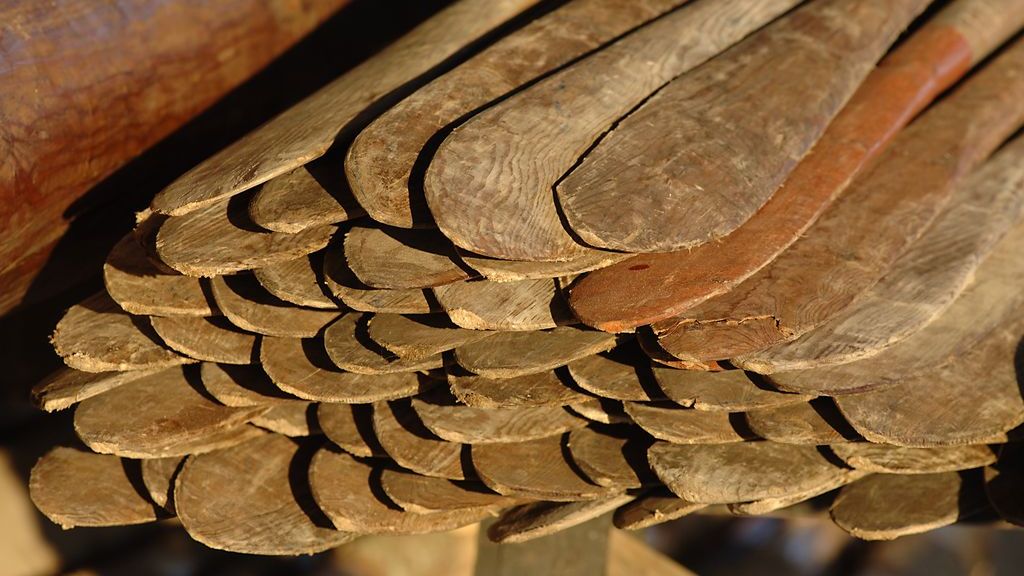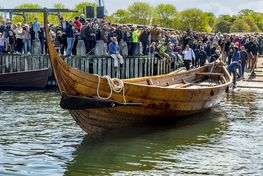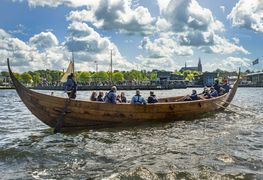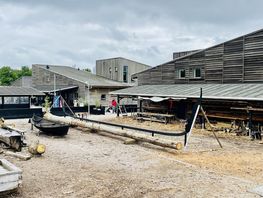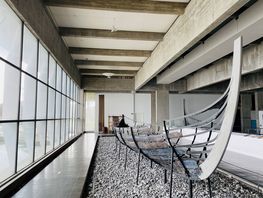From a Gislinge boat for the Sea Scouts to a brand-new full-scale reconstruction of a Viking ship for our own boat collection – projects with different purposes and approaches but all carried out within the Nordic clinker-building tradition. And museum visitors can follow along right where it happens.
A Gislinge Boat for the Scout’s Jamboree 2022
One of the summer’s major projects is the construction of a Gislinge Boat for the Sea Scouts. Construction began at the boatyard in the spring and now the boat is almost complete. In week 30, the boat will be moved out to the Scouts' Camp in Hedeland – the largest Scout camp in the Nordic countries, with over 40,000 participants. Here, the boat will be part of the camp's activity program, and the scouts themselves can take up tools and help the boatbuilders get the boat ready for launch in the lake at the camp. They will also have the opportunity to participate in various workshops focusing on maritime crafts, with knowledgeable guidance from the Museum's boatbuilders and education assistants.
The Gislinge Boat is a working boat from about 1125 AD, which was found during excavation in the Lammefjord in 1993. It is the boatyard’s fourth version of the Gislinge Boat but this boat will be slightly different from the three previous boats. And this is because the Scouts' boat – as it has become known here at the boatyard – is not part of an experimental archaeological project. The purpose of the project has not been to investigate an archaeological boat-find but to build a boat for the Sea Scouts that could meet the requirements they had for how and where the boat should be used.
Therefore, the Scouts' boat will be slightly larger than the original Gislinge Boat with a slightly different hull shape, to ensure an easily manageable boat for the Scouts. It has also been built with both reconstructed tools from the Viking Age and modern hand tools – something that guests are a little surprised by when they visit the boatyard but which quickly makes sense when they are told that the boat is not an experimental archaeological reconstruction.
You can follow the construction of the Scouts' boat inside the boatyard hall until Friday 22nd July, when it will be moved out to the Scouts' Camp in Hedeland.
Keep an eye on the Museum's Instagram profile for updates from the camp:
» https://www.instagram.com/vikingshipmuseum/
Rigging up Estrid Byrding
On the other hand, there will be full focus on experimental archaeology out in the Museum Harbour when the boatbuilders start rigging up Estrid Byrding, our new reconstruction of Skuldelev 3. The ship was built at the Museum's boatyard from 2017 – 2022 and was launched in early May. Rigging up is the next important step in the project, and when the sail and rig are ready, the ship will take to the fjord and be 'sailed in'. This is where we will get feedback on the ship's sailing characteristics and what this means for our understanding of Skuldelev 3 as a small cargo ship from the Viking Age.
For Estrid Byrding is not our first reconstruction of Skuldelev 3 – that was Roar Ege, which was launched in 1984. However, Estrid Byrding is not just a 1:1 copy of Roar Ege. In 2017, the Museum's ship reconstructor undertook a reinterpretation of Skuldelev 3's original form, and Estrid Byrding has thus a slightly different hull shape than Roar Ege. And we're excited to see what impact that has on the ship's sailing characteristics.
But first, the ship must be rigged up! You can follow the work at the boatyard and you can already see the sail that Estrid will come to carry. It’s hanging from the ceiling into the boatyard hall and is another important link in the project's experimental archaeological research.
For while the ship is newly built, the sail, which is made of wool, is already more than 30 years old. It is the same sail that was used on the Roar Ege until the ship was retired on land in 2016. The ship's hull had become too worn down to repair, but the sail was still in very good condition. So, we're going to reuse it on Estrid, our new reconstruction of Skuldelev 3.
The manufacture of sails was a time-consuming process and by continuing to use the same sail, we get the opportunity to investigate different aspects of Viking Age sail production and use of resources.
» You can read more about the construction of Estrid Byrding here..
Brand new project: first step towards a full-scale reconstruction of Skuldelev 5
Last but not least, the boatbuilders will soon embark on a brand new experimental archaeological project – we are going to build a new full-scale reconstruction of the Viking ship Skuldelev 5, which can be seen over in the Viking Ship Hall, a process that will last for the next four to five years.
And for all boatbuilding and Viking Age enthusiasts out there, there is a lot to look forward to with this build, because Skuldelev 5 is a rather unusual ship-find compared to other ship-finds from the Viking Age. The ship was built in Denmark around the year 1030 AD. It is 17.3 meters long and 2.5 meters wide - a long, narrow ship, equipped with 26 oars and a square sail, built for the quick and efficient transportation of fighters in times of conflict.
Pretty standard warship stuff so far. But what makes Skuldelev 5 so interesting to us is the way the ship was built. It is one of the few ship-finds from the Viking Age to have been built with re-used timbers right from the initial construction phase. It is also the only Danish ship from the Viking Age that has traces of carved ornamentation other the usual profiles found on planks, floor timber, etc. A small Ringerike-style carving can be seen on one of the re-used - possibly part of a larger carving on the original ship, which was then incorporated into Skuldelev 5's patchwork of old and new timber.
So far, the boatbuilders have erected a template of the ship's keel and stems over at the boatyard to give an idea of the ship’s scale and to signal that, soon, work on building a full-scale reconstruction of Skuldelev 5 will commence.
» You can read more about the excavation of the five Skuldelev ships here...
